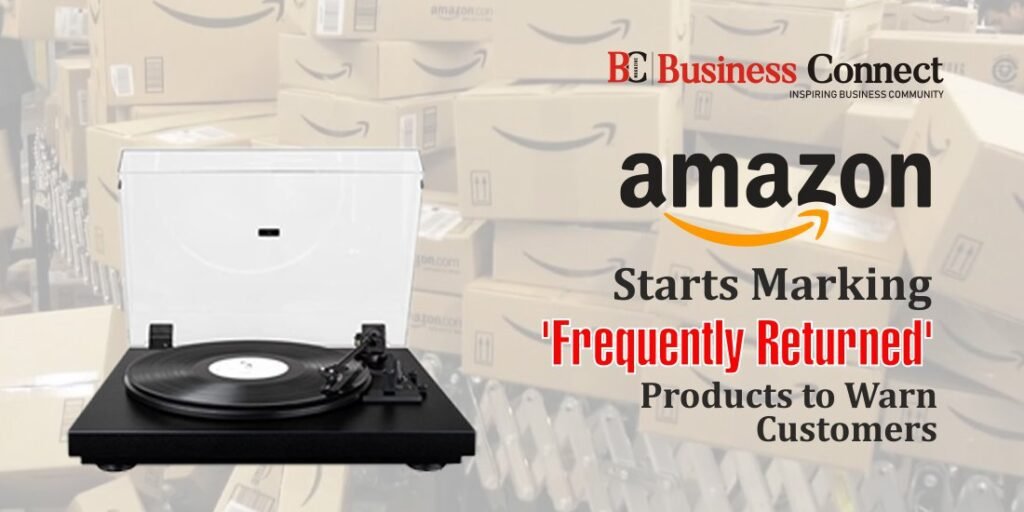Amazon Starts Marking ‘Frequently Returned’ Products to Warn Customers
Online order returns to sellers have always been difficult, and while most consumers pay nothing, retailers endure the majority of the costs, leaving them with no alternative but to sell off substantial portions of inventory at a loss. This is an unavoidable drawback of the rise in online sales. Customers cannot physically see an item before checking out, which makes online shopping a leap of faith. This is one main reason for the disparity. Amazon has come up with a solution that it thinks would lower the rate of returns and help everyone save money.
Amazon’s free and simple return policy for the vast majority of its products is an essential element of its marketing strategy, but a new feature the business is introducing reveals it’s attempting to encourage users to return purchases less frequently.
In order to ensure profitability amid economic downturns, CEO Andy Jassy is making the long-ago-discovered innovation that it is essential to monitor the frequency of returns. For instance, many devoted department store clients placed three or four mail-order outfits throughout the pandemic and maintained one. Simply put, customers were unsure of what size of a dress would fit comfortably.
Customers are being cautioned by Amazon about “often returned” goods offered for sale.
The world’s largest e-commerce company recently debuted the “frequently returned products” mark, advising customers to read customer reviews and product information before purchasing anything with a return rate that is noticeably higher than average for its category. According to Amazon’s current return policy, buyers can normally return new and unused items for free up to 30 days after purchase, unless the item is declared nonreturnable.
Customers still have to go through the bother of returning a purchase, and the Amazon platform is full of things that are false, poorly made, of low quality, and often cleverly advertised. Customers may be discouraged from purchasing such things if there is a clear indication that returns are common, and it may also motivate sellers to be honest in their listing information or at the very least address problems that result in more frequent product returns.
The most recent activity appears to be a component of Amazon’s bigger waste reduction initiative. The business received criticism in 2021 for trashing millions of unsold goods at its UK facilities. Later, Amazon made a commitment to drastically cut back on product disposal through a scheme that enables other retailers to resale returned goods as used goods.
Free returns can have an adverse effect on the environment because they frequently take up valuable warehouse space while waiting to be sold or disposed of in a landfill. Online merchants reported a rise in return rates during the covid pandemic, and returns are still higher than pre-pandemic levels.
This has led to greater expenses for merchants that facilitate storage and disposal as well as increased costs for consumers. Getting fewer returns means spending less money processing them, which is excellent news for the corporation, which has already eliminated 27,000 positions this year to reduce operating expenses.
According to a National Retail Federation analysis, “Goods returns would reach a record high of $761 billion in 2021.” While many businesses work to help retailers with this issue, the sad reality is that the high return rates associated with online shopping are mostly a result of the weak return policies of corporations like Amazon, all in the interest of capturing more market share in a fiercely competitive sector.
Amazon CEO Andy Jassy stated during a recent earnings call that the company would keep working to improve the effectiveness of its extensive logistics network. Following tougher steps like mass layoffs of personnel, the corporation may be adopting this to reduce return expenses. After seeing significant growth during the epidemic and then dealing with shifting consumer preferences, the company found itself in this situation.
Amazon hopes that the new warning label will discourage buyers from making purchases they may regret later and compel vendors to be open and honest in their listings. It’s simple for customers to cancel an Amazon order or item before the item ships, saving sellers time and money.
When the “often returned item” tag will be extensively used and in which international markets besides the US are still undisclosed by Amazon. Nevertheless, some sellers are already griping that Amazon’s marketplace penalises them too quickly and may interpret this as another blow to small firms.
Must Read:-
- Top 10 shoe brands in India for men & women 2023
- Top 10 Adorable Gifts for Your Special One
- Top 10 Countries with Maximum Indian Population as Citizens
- Top 10 Small Business Statistics You Need to Know For 2023
- Top 10 highest paid CEO in the World
- Top 10 richest person of India
- Top 10 Highest Paid CEOs of India
- Top 10 Most Selling Bikes and Scooters of 2022 in India
- The Success Story of Jeff Bezos
- Success Story Of Elon Musk
- Top 10 Business Magazine In India
- Top 10 Business Newspaper In India
- Top 10 Tourist Places in India, places to visit after lockdown



